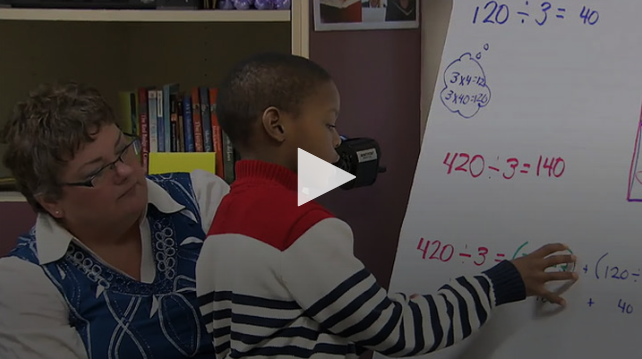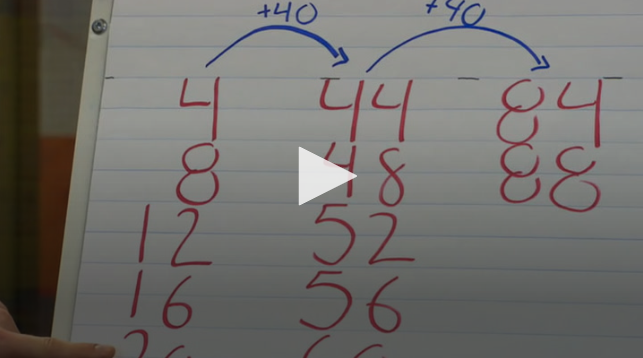We listen to hear what our students understand. We listen to hear our students’ emerging understandings. We listen to hear how students are doing. We listen to decide where to steer the discussion next. We design lessons to open up opportunities to hear our students’ thinking and for students to hear one another’s thinking. We ask questions to uncover students’ ideas and to build on what we hear. We listen to let students know they are heard.
Teaching is a listening profession.
Teaching in response to what we hear is complex. When we commit to having students’ ideas at the center of our instruction, we commit to listening to our students’ ideas. We commit to responding in responsible ways that support our students’ academic and social development. Teachers listen all day, in every subject and in between moments, too. And yet, we rarely (if ever) explicitly attend to how we listen. What do we listen to and for? Who do we listen to? What is the range of ways we listen and how do we purposefully select how to listen in any given moment?
One way we can pay attention to how we listen, is to notice how we tend to respond. Because listening happens in our brains, we can use our responses as an indicator of how we listened. Brent Davis’ work has helped us think about the different ways teachers can listen. For example, during a mathematical discussion, if we reply to a student by saying, “Right, the answer is 7,” we likely were listening evaluatively. We were listening for the right answer. This type of listening can limit students’ creative and critical thinking. If we respond by saying, “How did you get 7?”, we may have been listening interpretively. We were listening to understand a student’s strategy. If we respond with, “I wonder if that solution always works?”, we could have been listening generatively in order to generate new mathematics and orient children to co-generating ideas, together. Sometimes we may listen in multiple ways at once as we respond to what we notice about what children do and say.
How we respond to what we hear matters. It matters for students knowing their ideas are understood and valued. It matters because teachers create the listening culture in their classrooms. It matters because students listen the way they are heard.
What does it sound like to respond to students in ways that cultivate our own listening and our students’ listening?
From our learning alongside teachers and students, we have identified questions and responses that nurture listening. These are phrases teachers can say and students can say to each other. A few examples include:
•I am hearing you say ____. Am I understanding you?
•Let’s listen to ____ tell us about his idea.
•You’re building on ____’s idea.
•Let’s think about ___’s answer. What questions do we have for her?
•I’m curious, can you tell me about how you are thinking this through?
•Tell me more. You’re really challenging me to think about this in an important new way.
•Wow, you’re seeing something I didn’t see. This insight is important, let’s talk together about what it means.
•Great point, I am really learning from you… I need a moment to think about what you’re telling me.
•I’m curious about the ideas that are emerging in this conversation; let’s discuss them further as a group before we move on.
We wonder, what questions do you ask to support listening? How do you respond to what you hear in ways that cultivate learning and listening? What would you add to this list?
How can we use videos of classroom discussions to notice and get better at listening?
Videos of classroom discussions are a powerful place to notice and work on listening. One of our favorite videos, Reasoning About Division, takes us inside a mathematical discussion in Lynn Simpson’s fourth grade classroom.

REASONING ABOUT DIVISION
We never tire of observing Lynn and her students, as children explain their thinking and engage with each others’ ideas. In this video, students defend their position, they agree and disagree. Our favorite moment comes near the end of the video, when students revise their ideas based on what they’re hearing from their classmates. Previously, we’ve shared this video in professional learning sessions, to study what it sounds like for children to reason about their ideas and notice teaching moves that support such discussion. We’ve come to realize this video is also an opportunity to study listening. When we watch this video with a lens for listening, we notice the kinds of questions Lynn asks, and the kinds of prompts she uses. For example, we hear Lynn say:
- How did you know it was 100?
- Turn and talk about what you think the answer is, and why you think that.
- Can you explain why you think it is 140?
- Defend your answer to us.
- What are you thinking? You’re agreeing.
- What are you thinking? You’re disagreeing.
- So, what do you think, Jason, about what she said?
When we foreground listening, we notice how her responses open up opportunities to hear ideas from students.
Prompts for video-watching and noticing listening
We invite you to watch videos as a way of noticing and getting better at listening. For example, what do you hear in this video of Drew Crandall reasoning about multiplication and division with third grade students?

REASONING ABOUT MULTIPLICATION & DIVISION
As you observe this discussion and listen to students and their teacher, consider:
- What do you notice about questions that open up opportunities to hear students’ ideas?
- What do you notice about how the teacher and students respond to the ideas being shared? Which responses seem to facilitate meaningful opportunities for hearing one another’s thinking? Which responses help students feel heard?
- What do you notice about the nature of the task and how it creates opportunities for the teacher and students to listen to others’ ideas?
- How does listening, and being heard, help shape a culture of reasoning and belonging in this classroom?
- How does what you notice relate to your own teaching?
Pedagogical Listening
As we continue to learn alongside teachers and students about how they listen to one another, we put forth the idea of pedagogical listening. Pedagogical listening is robust teacher listening that cultivates a space where students can engage in productive struggle and think critically about their own and each others’ ideas. When teachers listen pedagogically they attend to students’ academic and social emotional learning. Pedagogical listening is an approach and professional disposition that aims to create a participatory classroom where:
- A learners perspectives, knowledge, and ways of knowing from their families, home, and community are valued.
- Intellectual risk taking, being uncertain, and making mistakes is supported.
- Sharing diverse ideas and learning from others is encouraged.
- All learners have opportunities to have their experiences and thinking shape the collective learning.
- All learners are challenged and supported.
- Interactions work to rehumanize learning opportunities in equitable ways that support children to thrive academically and socially.
Pedagogical listening is about creating meaningful interactions with learners over time – it cannot fully be measured in isolated moments. You can read more about pedagogical listening in our recent article, Actualizing the Rights of the Learner: The Role of Pedagogical Listening.
As a community, we’ve gotten really good at designing and facilitating classroom discussions. Classrooms are alive with children’s ideas! Now that we’re talking, let’s make sure we’re listening – listening for learning. It is because of this complex work that teachers do, that we believe teaching is a listening profession.







